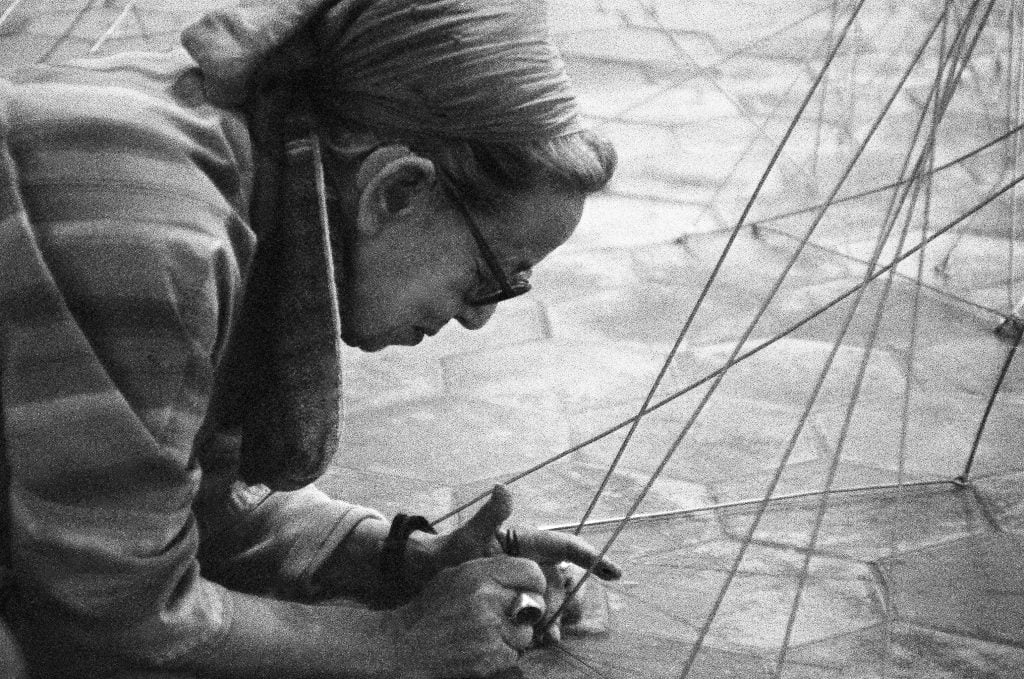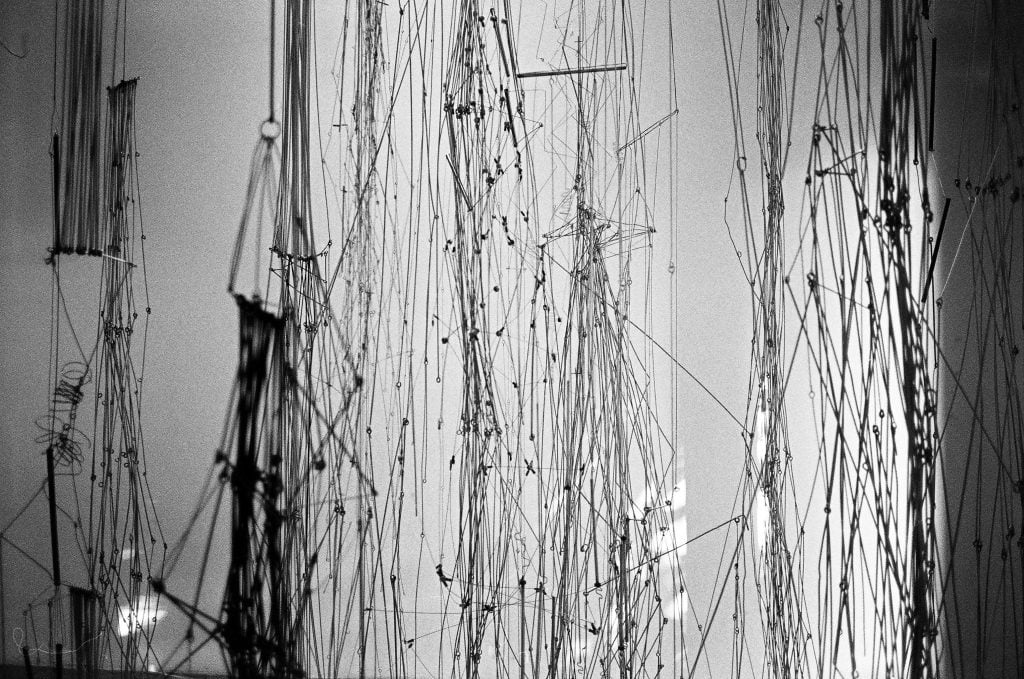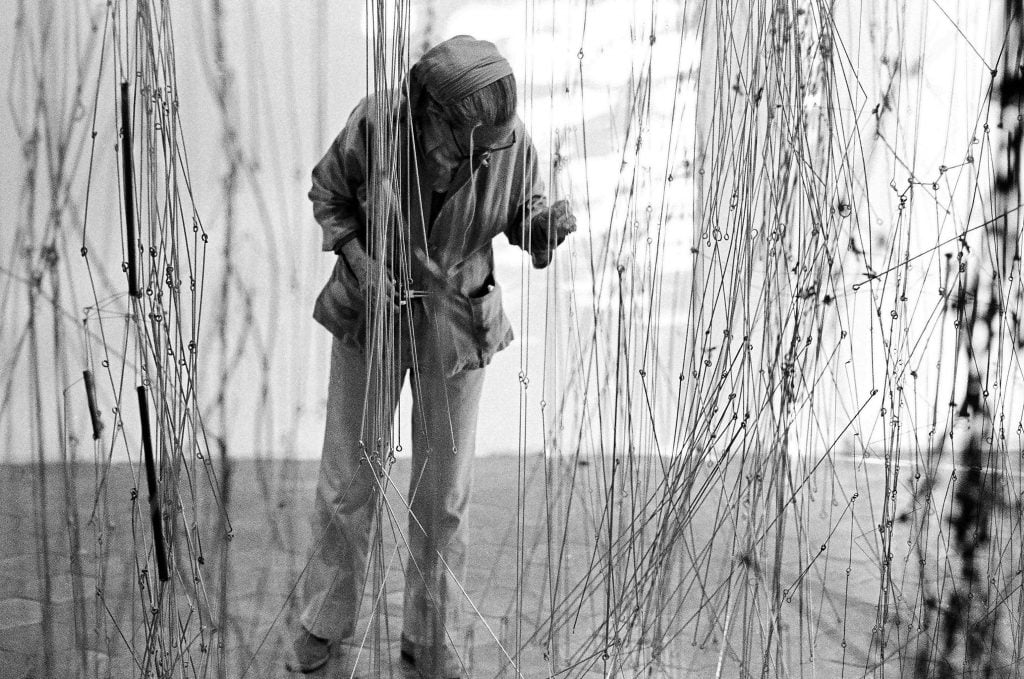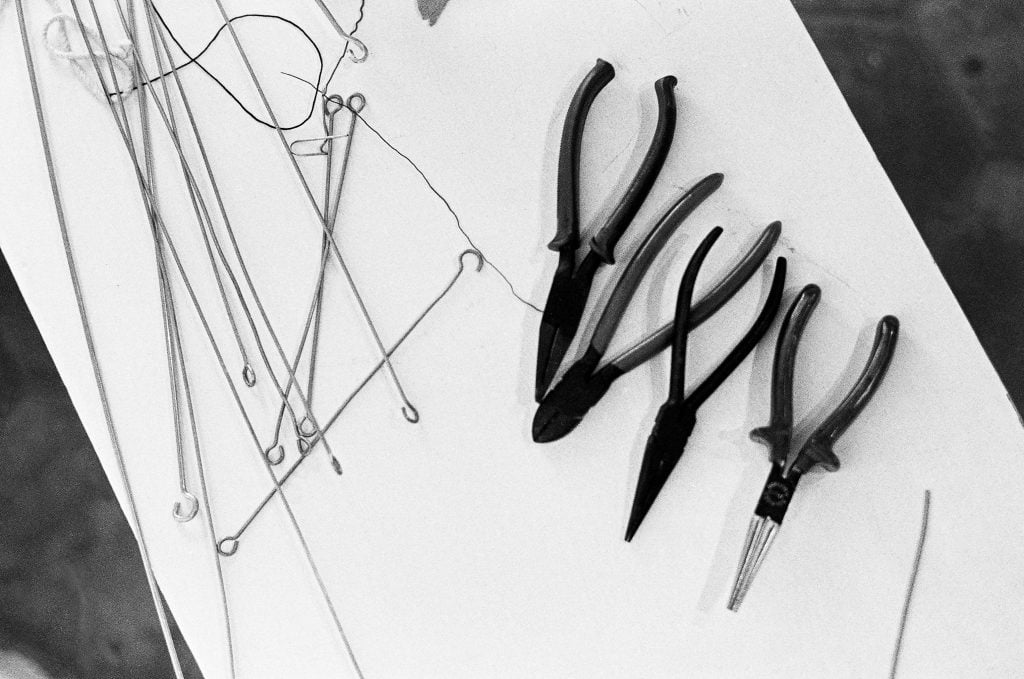People
Spending Her Life Outside the World’s Art Capitals, Venezuelan Artist Gego’s Meticulous Wire Sculptures Are Now in Global Demand
The artist is the subject of a traveling museum retrospective, currently on view at the Museo Jumex.

The artist is the subject of a traveling museum retrospective, currently on view at the Museo Jumex.

Devorah Lauter

An outpouring of interlinked metal strands jets out from the ceiling, splashing onto the ground and ricocheting up and outwards, where it stays suspended, as if scribbled by a giant hand onto thin air, in a fit of passion. This so-called “Chorro,” or stream, is in fact the painstakingly self-installed metallic language of the singular, long under-recognized German-Venezuelan artist known as Gego (1912-1994).
Now that wrong is on its way to being righted.
Gego is the subject of a major traveling retrospective, “Gego: Measuring Infinity,” on view at Museo Jumex in Mexico City until February 2023. The exhibition continues to the Solomon R. Guggenheim Museum in New York in March, before ending at the Guggenheim Bilbao. Simultaneously, a survey of the artist just opened at LGDR gallery in Paris, called “Lines in Space.”
Trained in architecture in Germany, where Gego was born Gertrud Louise Goldschmidt to a progressive, wealthy Jewish family in Hamburg, she didn’t begin making art until the age of 41, encouraged by her partner, the graphic designer and artist Gerd Leufert. Despite her late start, she soon enjoyed a renowned and influential art career in her adopted Venezuela, where Gego found asylum after fleeing the Nazi regime in 1939.
Stimulated by the local Cinetismo art scene and geometric abstraction, she was given a retrospective in 1977 at the Museo de Arte Contemporáneo de Caracas Sofía Imber. Her public works can still be seen throughout Caracas, where she taught at the Universidad Central de Venezuela and the Instituto de Diseño der Fundación Neumann.
Yet outside Latin America, Gego is still relatively overlooked.

“Chorros” installation at the Museo de Barquisimeto, 1985. Courtesy LGDR, photograph by Tony Russell.
“Our mission is not just to sell, but to widen the audience and knowledge of Gego,” said Emilio Steinberger, senior partner at LGDR, who curated the Paris exhibition with gallery co-founder Dominique Levy. This is LGDR’s third exhibition of Gego’s work since becoming the first international commercial gallery to work with her estate in 2015. “Whenever she’s shown in an in-depth way, she gets attention,” added Steinberger.
Critical to that mission is experiencing Gego’s creations in person. “It’s very poetic, sublime work,” to be enjoyed in real life, Steinberger added. “This ephemeral, wire sculpture is just not going to come across [online].”
Gego famously said that her art dealt with “transparency,” refusing to call her creations sculptures, which she felt were impenetrable by contrast. “Three-dimensional forms of solid material. Never what I do!” she wrote.
To that end, she playfully explored line as an “autonomous” entity, evolving from her architectural and engineering education at the Stuttgart Institute of Technology, where she was one of the last Jewish students to receive a diploma shortly after the Night of Broken Glass or Kristallnacht. The impact of her technical background on her unique visual language was explored in-depth at the Kunstmuseum Stuttgart in an exhibition earlier this year.
“I was trained as an architect, committed to draw lines with a definite meaning, lines that determine forms or spaces as symbols of limits, never with a life of their own. Many years later I discovered the charm of the line in and of itself,” she wrote, “that sometimes the in-between lines are as important as the line by itself.”

Gego working on the “Chorros” installation at the Museo de Barquisimeto, 1985. Courtesy LGDR, photograph by Tony Russell.
A highlight of the Paris exhibition is a free-standing “Chorro,” which Gego began in 1979, one of some 15 larger iterations of its kind. She later added to it her seminal “Reticulárea” forms (meaning “area of nets”) made of triangular, mesh structures composed of delicate wires or thin rods in a web of dissimilar geometric weaves. “Reticulárea” can splay and fill entire rooms like spontaneous constellations or fall like hanging tapestries. They are as irregularly organic, fragile, and cosmic as they are metallic forces of energy that vibrate in space. A network of contrasts, they have no real center, start, finish, nor discernible definition.
Partly thanks to her work being “based on doing” and the “delight by making it,” as she put it, Gego tended to evade artistic categories and currents. She intersected but skirted along the periphery of movements animating the South American art scene from the 1950s through the ‘80s. They included kinetic art, in which her friends were famously involved, including Jesús Rafael Soto and Carlos Cruz-Diez, as well as geometric abstraction with Alejandro Otero, and the regional Concrete art current.
“She was very avant-garde for her time, and would just be who she wanted to be,” remembered her granddaughter Ester Crespin Gunz at the LGDR opening, where she was easy to spot thanks to a strong family resemblance. A reserved person, who discussed little about her art with her family, Gego generally preferred working independently, though new research at the Kunstmuseum Stuttgart has shed light on her collaborations with other artists, such as the Venezuelan dancer and choreographer Sonia Sonoja.
“When she discovered the stainless-steel wires, she was free to work on her own, and was very spontaneous, direct from the head to the piece, because she did not need someone else to understand what she was doing,” said Crespin, who is an architect, and a founding member of the Fondación Gego in Caracas, established after the artist’s death. (Another grandson is the artist Elias Crespin.) In contrast, large public works and earlier sculptural forms in parallel lines made from heavier metal rods required the assistance of trained craftsmen.

Gego’s tools. Courtesy LGDR, photograph by Tony Russell.
Gego worked alone, or hired a student to help with larger, three-dimensional works, but her many drawings and watercolors on paper were done in the isolation of her studio, said Gego’s son, Tomás Gunz, speaking to Artnet News over the phone. Many of those works are included in the Paris exhibition, as well as the traveling retrospective. Other pieces on view include her sublime “Dibujo sin papel” [paperless drawings], mesh spheres and other forms, books, prints, “Bichos” (critters or bugs), parallel line works, and her later “Tejeduras” (weavings).
Though Gunz was conscious of his mother’s active, celebrated career in Venezuela, he said it was “only after she passed away and the Museum of Fine Arts Houston held the first international solo exhibition [in 2002] that we came to understand the relevance of her creations.”
That understanding is still in its early stages.
“Although a select group of scholars and curators have sought to establish Gego’s place in the modernist canon over the past two decades, she remains a little-known figure in the United States,” wrote Pablo León de la Barra, curator at large of Latin American art at the Guggenheim in New York, and his colleague, curator Geaninne Gutiérrez-Guimarães, in an email to Artnet News. Both helped develop the current retrospective, which aims to advance “a deeper understanding and appreciation of [Gego’s] oeuvre within the context of 20th-century modernism.” The New York edition will be the most comprehensive of the traveling retrospective, occupying five ramps of the Guggenheim’s rotunda, and highlighting Gego’s dialogue with other creators and the public.
Gego’s recognition was indeed boosted by the 2002 traveling international retrospective at the MFA Houston exhibition, originally organized by the Museo de Bellas Artes de Caracas, while another important step came with a first major show in Germany in 2013 at the Hamburger Kunsthalle. It continued to the Kunstmuseum in Stuttgart and the Henry Moore Institute in Leeds, England.
The Hamburg exhibition, “Gego. Line as Object,” “was a starting point for the reception of her work in Europe, and for many people it was an eye-opener,” said the exhibition’s co-curator Brigitte Kölle, “but there’s still a way to go.”
At the time, the museum held a parallel exhibition of works by artist Eva Hesse, who also fled Hamburg on a kindertransport train for Jewish children.
Kölle said she did not think Gego’s Jewish identity contributed to her late reception in Germany, where she noted that since the 1990s researchers have more actively sought information on German-Jewish artist refugees of World War II. However, “there’s also a certain amount of being ashamed,” she said. The 2013 show also included a commemorative plaque to Gego, which a city official placed at her former home.

Gego working on the
“Chorros” installation at the Museo de Barquisimeto, 1985.
Courtesy LGDR, photograph by Tony Russell.
The sixth of seven children born to the Goldschmidt family, which had run the J. Goldschmidt Sohn bank since 1815, Gego was the last person to leave the family’s villa in Hamburg. Determined to wait until she received her architecture diploma, at the last minute she donated the house furniture to a charity, locked the front door, and threw the key into the Alster River.
“Looking back now, [staying behind so long] was risky. The same risk to go to Venezuela, almost without knowing where it is on the map,” said Gunz. “Someone has to be the last one.”
Gego was granted permission to enter Venezuela from England, where her immediate family had already taken temporary refuge. In Venezuela she struggled to find work in architecture as a woman and a foreigner, and married Ernst Gunz in 1940. Together they opened a wooden furniture design workshop. The couple had two children, Tomás and Barbara. In 1951, they separated, and Gego met her life partner, Gerd Leufert.
Gego’s late discovery in North America and Europe has been chalked up to her being a woman artist based in Latin America, who, unlike some of her better-known peers from the Venezuelan post-modern scene, opted to stay in Caracas, rather than spend more time in art capitals like Paris or New York. Not being represented by a major commercial gallery is another.
LGDR has placed Gego’s work in institutions like the San Francisco Museum of Modern Art and the Guggenheim Abu Dhabi, and says they’ve had a lot of museum interest, particularly since the artist has few large works available for sale. Pieces range from $20,000 for an etching, while works on paper are priced between $50,000 and $100,000, and three-dimensional forms go for $250,000. The rare free-standing “Chorro” costs just over $1.5 million.
Gego did spend short periods in the U.S. In the ‘60s she worked at the Pratt Institute in New York, then studied pedagogy at the University of California, Berkeley, and prints at the Tamarind Lithography Workshop in Los Angeles. In 1965, the Museum of Modern Art in New York exhibited and acquired her mesh Esfera (sphere), and in 1971 she presented her “Los Chorros” series in a solo exhibition at the Betty Parsons Gallery in New York.
“If she had stayed, like other Latin American artists who migrated to the States for a longer time, she would have probably been even more recognized,” said her son. “But that was not her goal at that moment. Venezuela was so active [in terms of] the artist life, that she thought—it’s going on there.” He added: “She was not looking to be famous.”
That may be, but Gego’s granddaughter Ester also wonders if the world needed a little more time to catch up to Gego. “Maybe we were not prepared to understand what she made until now,” she said.